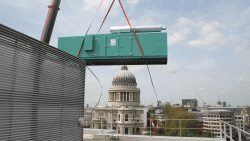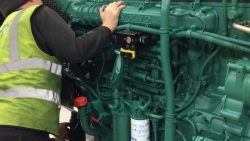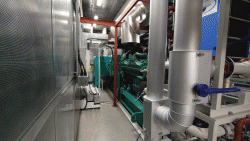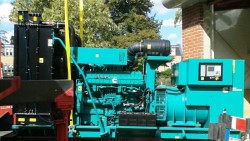The customer: Established in 1931 and currently based in Central London. They specialise in the complete installation of Mechanical & Electrical services to all sectors including quality office developments, commercial and public buildings, data centres, retail, health, education, leisure, hotels, residential and pharmaceutical.
The end-client: Built in 1965 on the site of a Victorian Mansion in Buckinghamshire, the design led to an award from The Royal Institute of British Architects (RIBA) in 1967. The Hospital was expanded in 2013 and 2019 to include a new recovery centre and emergency department respectively.
The hospital is also home to a renowned plastic and reconstructive surgery unit founded by pioneering British plastic surgeon Stewart Harrison, and provides many sources of care including emergency, trauma and orthopaedic surgery.
Having worked with the customer over several years on various generator installation projects for a variety of organisations including Government buildings, NHS Trusts and distribution centres, we were contacted by their Senior Estimator inviting us to tender for proposed generator works, working alongside them, at a specialist NHS site.
We were of course delighted to be considered for the vital power upgrade for this specialist NHS hospital that provides healthcare services for circa. 900,000 people in the home counties of Berkshire, Hampshire, Surrey and Buckinghamshire.
Expansion of services to the Hospital in recent years, including an extended and refurbished Chemotherapy Unit and Women’s Services department and more recently a new £49M four-storey Emergency Assessment Centre, creating one of the most innovative care units in the NHS, had put increased demand on the hospitals existing standby power. The Hospital was looking for a solution to deliver suitable back-up power to keep the Hospital, and its critical facilities running in the event of a mains power outage.
On invitation our sales manager visited the Hospital to carry out a site survey of the current on-site generators to enable him to identify and understand the Hospitals requirements including the location and size of the new/replacement generators before submitting a final project proposal.
Prior to submitting a proposal, an internal meeting was held between our Sales and Projects teams to discuss the project in greater detail along with any challenges that we may have to overcome before and/or during the project including maintaining power to the site throughout.
As three of the new sets were positioned externally, we were asked to take into consideration any noise and pollution in regards to the location of the Psychiatric Unit and Coronary Care Unit generators, as they were in close proximity to the ward blocks where windows were observed to be routinely opened.
Along with five other companies, our sales team were invited for a proposal interview with the Hospital’s estates department and consultants to put forward our proposal stating how we intended to carry out the works, stay within budget and manage the project time line.
After 3 weeks of waiting we were notified by our customer that we were the preferred supplier for the project and would work alongside our customer once again on this significant assignment, which we were obviously thrilled to hear.
Subsequent to further meetings with our customer and the Hospital to refine the programme and discuss our methodology, our sales manager handed to project over to our Projects Division, where a dedicated Project Manager was assigned to proceed with the works.
Once all paperwork, contracts, drawings and technical submissions was approved, the project manager gave the order to the manufacturer to proceed with the production of the generators so the project could commence.
Following the Christmas break, our engineers began the process of decommissioning, dismantling and removing the existing four generator sets from the Maternity, CCU and Psychiatric Units in succession ready for the installation of the replacement equipment.
Our engineers began by isolating, making safe and dismantling the two Maternity Unit generators from the ground floor plant room and skating them away from the opening of the building ready for removal. This was followed by modifications to the plant room which including the repositioning of the air inlet louver to suit the new apertures and replacement of the fuel pumps between existing bulk tank and new day tank.
Subsequent to changes made to the roadway alongside the plant room to ensure it was adequate for the point load limits from the crane outriggers, the mobile crane arrived and positioned itself ready to lift the equipment onto the arriving articulated lorry. The lorry arrived with the new equipment which the mobile crane offloaded before placing the redundant equipment onto the empty lorry. The crane then manoeuvred the new day tank, generators and exhaust silencers into the generator room ready for connection by our engineers.
This was immediately followed by the decommissioning, dismantling and removal of the redundant equipment and the delivery and positioning of the new generator system for the Coronary Care Unit onto the vacated original plinth, followed by the Psychiatric Unit generator system once the overhanging trees and vegetation had been removed and the original plinth extended by 1.5 meters to allow for the new equipment.
With the Emergency Assessment Centre being a new building, the proposed location of the containerised generator system had to be cleared of vegetation and trees prior to a plinth being laid adjacent to the new building. Once this was completed the new equipment was positioned ready for connection.
To enable the new generators to communicate with the existing LV switchboards, the current generator controllers were up-fitted to Deepsea 8610 and all existing installed electronic PCB’s replaced with conventional AVRs (automatic voltage regulator) and a governor actuator controller along with the internal wiring and current transformers.
This was needed to allow the generators to synchronise to the mains supply allowing for periodic full load testing without any interruption to the supply.
Testing and Commissioning of the Generators
Prior to commissioning of the equipment, our Commissioning Engineer checked all generator installations for completion before energising auxiliary electrical supplies to the generators. He then tested and proved the fuel transfer system followed by a test run of the generators offload.
Utilising our own resistive loadbank and temporary load cables, successful Site Acceptance Tests (SATs) were carried out on all site equipment, attended by our Project Manager, Commissioning Engineer and a representative of the customer. The test is performed to ensure that the equipment conforms to the client’s request, is correctly installed, safe to use and fit for purpose and well as demonstrating the control and protection features for the generator to the client.
On completion of all satisfactory tests, commissioning and training, and with minimal disruption to the site throughout, The Generator Company handed over to the client and left the site clean, tidy and in full working order.





